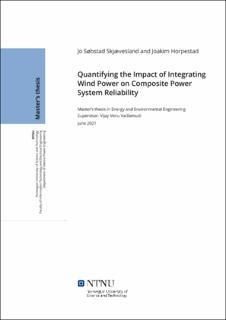| dc.description.abstract | Due to global efforts to combat climate change, renewable energy is currently seeing a boom in growth, with wind energy leading the way. Electric power generation from wind energy is different compared to that from conventional sources, due to the intermittent nature of the wind speed. Therefore, the operating characteristics of the wind energy facilities have a different impact on the reliability of the power system compared to that of conventional sources. The rapid development of wind energy installations can lead to increased pressure on electric power utilities. This thesis identifies and develops methods to evaluate and quantify the impact of significant wind power penetration on the reliability of composite power systems through probabilistic Monte Carlo Simulation methods.
Two fundamental Monte Carlo Simulation methods, the Sequential State Transition method, and the Non-sequential State Sampling method, are selected to include wind power penetration in composite system reliability assessment. Two different wind speed models, the auto-regressive moving average (ARMA) wind model and the Weibull distribution-based wind model, are included and compared in the composite system reliability assessment. The wind power modelling considerations are selected through an extensive literature review, which examines the state-of-the-art on the main topic of the thesis. The developed methods are applied to a DC-based contingency solver and an AC-based contingency solver for composite system state evaluation. The developed in-house software tools are tested on standard test systems suited for composite power system reliability evaluation through appropriate probabilistic indices and compared with selected corresponding benchmark results from the literature.
The thesis applies different wind speed regimes to case studies and compares the impact on the reliability of the system delivery points and the overall systems. Wind speed correlation between multiple wind sites is identified as an important parameter in the wind modelling process and is included in the wind speed models. The priority order load curtailment philosophy is used to control the load curtailments at the system delivery points. It is observed that the characteristics of the wind speed regime, transmission network, degree of wind speed correlation, and choice of load curtailment philosophy have a significant impact on the reliability of power systems with significant wind power penetration. | |
